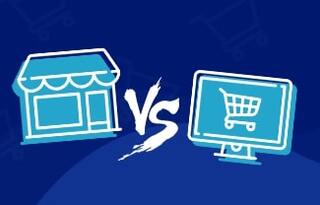eCommerce is a buzzword in the modern online business industry. More and more entrepreneurs are dedicating themselves to the development of this market segment. It creates an eCommerce frenzy, which can cut both ways.

We can hardly deny the progress eCommerce community made over the past years. It's now an independent business segment with its own target audience and turnover. At the same time, as new people master eCommerce, it's getting significantly harder to jump into it with every single year.
This undoubtedly creates a need to be professional in everything to keep your head above the water of the eCommerce scope rivalry. And no eCommerce business will withstand the competition without horizontal or vertical integration.
Whether you do B2B or B2C business, it's essential to choose your marketplace business model - either vertical or horizontal - and stick to it. It's the only way to deliver the required value. Let's figure out the differences between horizontal and vertical eCommerce models and find out which one fits your business the best.
Horizontal E-Commerce: Sell Everything, Focus on Nothing
The horizontal eCommerce business model implies selling all and everything reaching the broadest audience possible. Basically, the horizontal eCommerce project is a digital one-stop shop: you can buy anything you need in one place without problems with finding the product category you are looking for.
The best explanation is a live example, and we have one. Consider Amazon as the standard for a horizontal eCommerce. Having started as a bookseller, the company expanded its product range to an unbelievable range over time. You can buy literally everything on Amazon: from a pair of jeans to a combat knife.
And that's exactly what makes the horizontal model so special. It consolidates numerous market segments to achieve greater coverage. However, such a diversified marketing strategy has its downsides as well. If you're spending all your time on different market segments, you don't have any chance to dominate some specific industry.
Vertical eCommerce: Focus on One Category, Master It

Unlike the horizontal model, vertically oriented businesses rely on industry domination. They focus all their efforts on providing the best services in one particular scope. Vertical eCommerce is about being the best in your industry at the expense of target group limitation.
Vertical integration allows your eCommerce business to unify its customer relationship and product marketing strategies. As you limit yourself to a specific product category and its relatively narrow consumer audience, it's much easier for you to develop a single marketing system and apply your strategy in a consistent and step-by-step manner.
The vertical eCommerce model means your business competes for the market segment domination but has zero influence on other industries. That's the price you pay to be the best in your scope.
Horizontal eCommerce: the Whys and Hows
As you may have guessed, both models have their strengths and downsides. Let's discover the most substantial benefits of the horizontal eCommerce system you can profit from and the most dreadful nightmares it can bring to your business.
The Positive Impact: The Maximum Coverage and Immunity to Market Volatility
Horizontal integration means your business addresses the issues of the majority of members of the eCommerce consumer community. Striving to expand horizontally, you concentrate on capturing more and more market scopes. And this is your main strategic weapon, as countless shoppers all over the world use your services.
One more reason to opt for the horizontal approach is its diversification. Selling everything from pajamas to audio processors, you make sure that you won't be put out of business by a sudden market twist. One industry's recession is always balanced with another's rise. This secures your growth, regardless of the market volatility of any severity.
Horizontal eCommerce Flaws: No Opportunities for Narrow Specialty
On the other hand, horizontal business integration doesn't let you focus on any industry. Instead, it forces you to concentrate on expansion. This brings certain difficulties.
For instance, the horizontal model requires much more sophisticated marketing strategy, as you need to keep up with countless scopes at the same time. You need to be able to sell books, coffee, smartphones, and other products at the same time. Of course, you can always decide on the range of industries to cover in order to make sure your strategy won't get overcomplicated.
All in all, here are the most significant aspects of horizontal eCommerce:
- Excellent market coverage;
- Outstanding versatility and diversification;
- Limited impact in each individual industry.
Now, let's figure out what vertical integration has to offer.
Vertical eCommerce: The King of the Narrow Hill
VMS (Vertical Marketing System) is the exact opposite of the horizontal approach. It implies concentrating all your efforts on conquering a single market scope. Whether you sell sledgehammers or coffee mugs, it should be the only thing your business specializes in.
The whole point of vertical integration is to bring the best purchase conditions to a small audience. Limiting yourself to a narrow target group, you can deliver greater value with the same expenses. It makes consumers choose you over the competitors. But what makes it feasible?
The point is, by creating a marketing plan for only one segment you save a considerable amount of time and money. It's significantly easier to keep track of a single market sector than to develop a solution for several ones.
Vertical Integration Risks: High Dependency on the Market
While being dominant in your own territory is beneficial, it adds some risks to your business. Most importantly, you depend on your industry a lot. Let's consider this aspect using an example.

Imagine that you are selling, let's say, Bluetooth trackers. These lovely devices are in trend now, and if you've captured the niche, well, you are golden. However, as soon as these devices go out of trend, you will face certain troubles. As you've dedicated all your effort to become the leading tracker seller, you have no backup revenue sources to keep your business alive.
As you see, the vertical integration is only relevant when fundamental market research is conducted. You need to be 100% sure in the stability and growth potential of your market sector to opt for this model. Trying yourself as a vertical business owner in an unexplored industry is counting solely on luck. Don't make this mistake and learn the market segment before integrating your eCommerce vertically.
On the whole, here are the most substantial specifics of vertical eCommerce you should remember:
- Concentration on one product category;
- Dominating the market due to providing better services and product quality;
- Lack of flexibility;
- Business risks related to market volatility.
The Bottom Line
Vertical and horizontal eCommerce models are effective when implemented correctly. We can hardly name the better one for a marketplace. Just remember to integrate your business horizontally if you want to reduce risks and cover broad audience, or implement the vertical model if you are sure in your scope's prospects.

After all, choosing your model isn't the primary issue. It's all about adopting your eCommerce to solve the consumer's problem more efficiently. Be customer-oriented, and it'll become much easier to choose between the eCommerce integration options we have covered today.
If you need extensive eCommerce expertise in your marketplace project, make sure to reach out to Roobykon today. Our professionals will be glad to help you create a marketplace and integrate your business. So get in touch!










